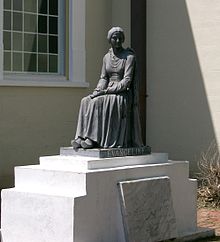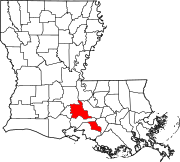St. Martinville, Louisiana
The city of St. Martinville is the parish seat of St. Martin Parish, in the U.S. state of Louisiana, located on Bayou Teche, sixteen miles south of Breaux Bridge, eighteen miles southeast of Lafayette, and nine miles north of New Iberia.
Geography
St. Martinville is located at 30°7′30″N 91°49′50″W / 30.12500°N 91.83056°WInvalid arguments have been passed to the {{#coordinates:}} function (30.125053, -91.830593)Template:GR.
According to the United States Census Bureau, the city has a total area of 3.0 square miles (7.8 km²), of which, 3.0 square miles (7.8 km²) of it is land and 0.33% is water.
Its terrain is mixture of swamp and prairie.
Area code: 337
ZIP code: 70582
History
In the 16th century the area between the Atchafalaya River, in Louisiana, the Gulf of Mexico and Trinity River, in Texas, was occupied by numerous Indians tribes or Subdivisions of the Atakapa. The Indian Territory was not closed to outsiders and several traders roamed through it on business. However, it only began to be settled by Europeans after Louisiana was founded in 1699. The territory between Atchafalaya River and Bayou Nezpique, where Eastern Atakapa lived, was called Attakapas Territory. The French colonial government gave land away to soldiers and settlers.
Attakapas Post was founded on the banks of the Bayou Teche and settlers started to arrive. Some came separately from France, such as the Frenchman Masse, who came in 1754 from Grenoble, and the French Gabriel Fuselier de la Claire in 1760. Fuselier bought all the land between Vermilion River and Bayou Teche from the Eastern Attakapas Chief Kinemo. It was shortly after that a rival Indian Tribe, the Appalousa (Opelousas) coming from the area through Atchafalaya River and Sabine River, exterminated the Attakapas (Eastern Atakapa).
Then other European settlers came in groups, such as the first Acadians from Nova Scotia, who were led there in 1763 by Jean Jacques Blaise d'Abbadie who became Governor. In 1768-1769 fifteen families arrived from Pointe Coupee. Their members came from Santo Domingo (French Saint Domingue, today Haïti) or from Paris via Fort de Chartres, Illinois. Between the arrivals of the two groups, the French captain Etienne de Vaugine came in 1764 and acquired a large domain east of Bayou Teche.
On April 25, 1766, after the arrival of the first Acadians, the census showed a population of 409 inhabitants for the Attakapas region. In 1767 the Attakapas Post alone had 150 inhabitants before the arrival of the 15 families from Pointe Coupee.
Napoleon sold Louisiana in 1803 to the United States through the Louisiana Purchase. The organizing of the Attakapas Territory took place between 1807 and 1868, culminating in the creation of the St. Martin Parish. Attakapas Post was named St. Martinville.
Demographics
As of the censusTemplate:GR of 2000, there were 6,989 people, 2,496 households, and 1,722 families residing in the city. The population density was 2,330.1 people per square mile (899.5/km²). There were 2,778 housing units at an average density of 926.2/sq mi (357.5/km²). The racial makeup of the city was 35.78% White, 62.84% African American, 0.20% Native American, 0.14% Asian, 0.34% from other races, and 0.69% from two or more races. Hispanic or Latino of any race were 1.04% of the population.
There were 2,496 households out of which 33.6% had children under the age of 18 living with them, 38.1% were married couples living together, 26.2% had a female householder with no husband present, and 31.0% were non-families. 27.8% of all households were made up of individuals and 12.5% had someone living alone who was 65 years of age or older. The average household size was 2.67 and the average family size was 3.28.
In the city the population was spread out with 28.2% under the age of 18, 9.2% from 18 to 24, 26.5% from 25 to 44, 21.2% from 45 to 64, and 15.0% who were 65 years of age or older. The median age was 35 years. For every 100 females there were 83.5 males. For every 100 females age 18 and over, there were 79.8 males.
The median income for a household in the city was $19,600, and the median income for a family was $28,711. Males had a median income of $28,946 versus $18,314 for females. The per capita income for the city was $10,529. About 26.9% of families and 31.2% of the population were below the poverty line, including 39.4% of those under age 18 and 31.2% of those age 65 or over.
Economy
The economy of St. Martinville is fueled by agriculture, tourism and the hardworking spirit of the community. Agricultural production mainly yields crops of crawfish and sugar cane.
- St. Martin Parish contributes over 8,000,000 pounds of wild crawfish from the Atchafalaya Basin and another 14,000,000 pounds harvested from farming ponds annually to the overall production of Louisiana crawfish.
- The Louisiana Sugar Cane Co-Op and historic St. John Mill, which is administered in St. Martinville, manage about 34,000 sugar cane producing acres throughout the State of Louisiana.
- Cajun Chef Products, Inc. is the largest employer in the city. For 30 years, the Bulliard family has built a tradition of supplying quality Cajun food products nationwide. The business that began in 1958 with one product now distributes more than 250 products through fast food and other restaurants as well as other institutions. Approximately 100 employees maintain the local plant.
- Peppers Unlimited of Louisiana, Inc. employs approximately 60 people from the St. Martinville area. The Bulliard family hot sauce recipe dates back to the turn of the century, in 1910. There are four generations of Bulliards now represented in the pepper business. Products processed at the St. Martinville plant are made under the Louisiana Supreme label or private labels and are sold internationally.
Society

St. Martinville is widely considered to be the birthplace of the Cajun culture and traditions, and it is in the heart of Cajun Country. There has been a true multicultural community in St. Martinville, with Cajuns, Creoles (French coming via the French West Islands - Guadeloupe, Martinique and Santo Domingo), French, Spaniards, African and African Americans.
Once New Orleans was founded and began to have epidemics, some New Orleanians escaped the city and came to St Martinville. Its nickname, Petit Paris ("Little Paris"), dates from the era when St. Martinville was known as a cultural mecca with good hotels and a French Theater that featured the best operas and witty comedies.
The third oldest town in Louisiana, St. Martinville has many buildings and homes with beautiful architecture, such as the historic St. Martin de Tours Catholic Church and La Maison Duchamp on Main Street. The church was dedicated to Martin of Tours in France, where a St Martin de Tours church can be found. There is also one in Layrac, France, the birthplace of Pierre Nezat who settled in 1768 in St Martinville.
St. Martinville is the site of the Evangeline Oak made famous in Henry Wadsworth Longfellow's poem. It is also the location of an African American Museum, and is included as a destination on the Louisiana African American Heritage Trail.
People from St. Martinville
Jefferson J. DeBlanc (born February 15, 1921), World War II ace fighter pilot and Medal of Honor recipient, resided in St. Martinville before and after the war. The heroic story of how DeBlanc became an "ace in a day" was recreated in 2006 using computer graphics and depicted in "Episode 5: Guadalcanal" of The History Channel's series Dogfights, for which he provided first-person commentary.
St. Martinville is the birthplace of Paul Jude Hardy (born October 18,1942), the first Republican to be elected lieutenant governor of Louisiana, serving from 1988 to 1992. Hardy was previously a member of the Louisiana State Senate and was the Louisiana Secretary of State from 1976 to 1980. As of early 2007, Paul Hardy was a practicing attorney in Baton Rouge.
Festivals
- La Grande Boucherie des Cajuns - sponsored by La Grande Boucherie des Cajuns, Inc., a Louisiana non-profit organization benefiting the youth of St. Martinville and other civic projects
- Pepper Festival - sponsored by the Kiwanis Club of St. Martinville
Attractions
St. Martin de Tours Church is the oldest church parish in southwest Louisiana. It is known as the Mother Church of the Acadians because it was founded in 1765 upon the arrival of Acadians in this area. The current building has served as a center for religious activities in this predominantly Catholic community for over one hundred fifty years. Behind the church, on the site of the original cemetery, monuments mark the participation of Acadians and others in the American Revolution.
La Maison Duchamp on Main Street in St. Martinville, Louisiana was built by Eugene & Amelie Duchamp in 1876 as their town house. This St. Martinville landmark house has been placed on the National Register of Historic Places; therefore, future generations will be able to marvel at its creative architecture and remember times past.
Duchamp Opera House, which dates to the mid-1800s, hosted many theatrical companies in its lifetime and has recently been completely restored. It once again hosts theatrical companies on the second floor.
The Evangeline Oak, made famous in Henry Wadsworth Longfellow's poem, "Evangeline," stands on the bank of the Bayou Teche.
At the side of the St Martin de Tours church, a monument dedicated to the Militiamen of St Martinville (36 ? all militiamen were French Creoles, excepted 3 Acadians, 3 Americans and 1 whom citizenship was not known) who have taken part with General Bernardo de Galvez to the "Capture of Baton Rouge in 1779” -Battle of Baton Rouge. Monument erected by the Louisiana Society Daughters of the American Revolution.
Sister cities
- Ploermel, Brittany, France
- Bouctouche, New Brunswick, Canada
- Chaudfontaine, Wallonia, Belgium
- Goree Island, Senegal, West Africa
References
- Jack Claude Nezat, The Nezat And Allied Families 1630-2007, Lulu 2007. ISBN 978-2-9528339-2-9, ISBN 978-0-6151-5001-7
The author is one of the descendants of "Alexandre of Attakapas", Nezat Alexandre, born 1781 in Attakapas Post and died 1824 (Source Hebert).
External links
- City of St. Martinville
- "On The Road To St. Martinville, Louisiana," an on-line photo journal of historic St. Martinville, Louisiana.

